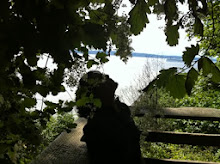earnest and aerobic light,
not the complacent kind.
It gets fired up by the ocean, and believes
in its own ability to reinvent
“It is hard to explain the light here,
earnest and aerobic light,
not the complacent kind.
It gets fired up by the ocean, and believes
in its own ability to reinvent
the vapid into the vatic,
the sore, serene,
torpor to fever,
temblor and squall to static.
I know you have light in other places.
I have lived in other places
and found curb to polestar endearing.
What can I say? Everywhere
dawn wears its mantle of emblem,
cuing insomniac, paperboy, baker.
Here in these fringe towns
yolked by Coast Highway and
the old mission route, El Camino Real,
we are awaken neither more beautiful
nor more true, but the light
brings the possible on particle,
seducing the muscles and liquids of your eye.
The possible weights little, tastes
like coriander or thyme,
and resembles its sister, the probable,
whose features are more sharply defined,
whose finest hour is dusk.”
—Hédi Kaddour, “Divided,” from The Paris Review 159, Fall 2001
not the complacent kind.
It gets fired up by the ocean, and believes
in its own ability to reinvent
“It is hard to explain the light here,
earnest and aerobic light,
not the complacent kind.
It gets fired up by the ocean, and believes
in its own ability to reinvent
the vapid into the vatic,
the sore, serene,
torpor to fever,
temblor and squall to static.
I know you have light in other places.
I have lived in other places
and found curb to polestar endearing.
What can I say? Everywhere
dawn wears its mantle of emblem,
cuing insomniac, paperboy, baker.
Here in these fringe towns
yolked by Coast Highway and
the old mission route, El Camino Real,
we are awaken neither more beautiful
nor more true, but the light
brings the possible on particle,
seducing the muscles and liquids of your eye.
The possible weights little, tastes
like coriander or thyme,
and resembles its sister, the probable,
whose features are more sharply defined,
whose finest hour is dusk.”
—Hédi Kaddour, “Divided,” from The Paris Review 159, Fall 2001


























